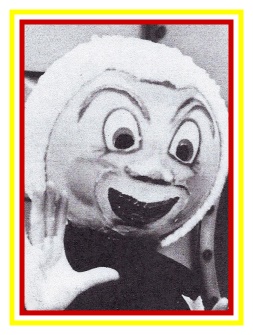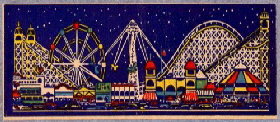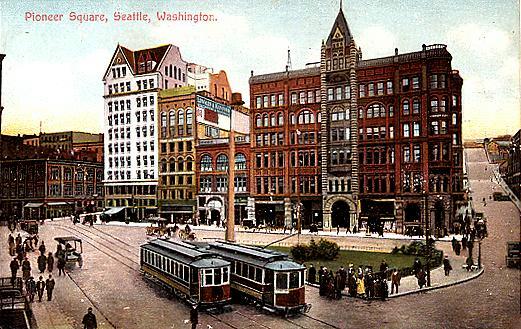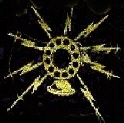 |
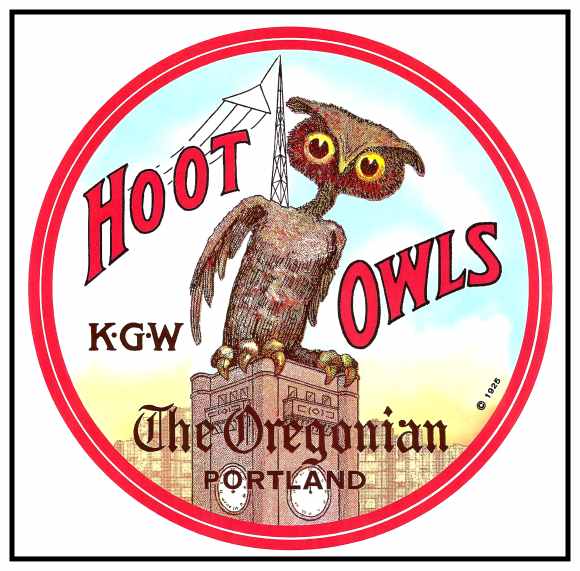 |
|||||||||||||||||||
|
|
||||||||||||||||||||
 |
||||||||||||||||||||
|
|
 |
 |
|||
|
Amusement Parks came into being in 1895 when Sea Lion Park opened at Coney Island in New York. Bringing pleasure to the masses, Amusement Parks represented a taste of the future. This new phenomenon came to every major city when many Americans still used horses and buggies to travel from the farm to the city. People could live out the thrills of their fantasies by experiencing the laws of gravity and mechanical simulations. Electricity was fairly scarce in rural America and it opened the door for a lot of new inventions. Telephones were still rare in most homes. Every big town had at least one amusement park. Electric companies built the Trolley systems that transported the masses to the Trolley Parks that were built at the end of the line. Portland had The Oaks and Seattle decided to build Luna Park in West Seattle, west of Alki Point, and it operated from 1907 to 1913. |
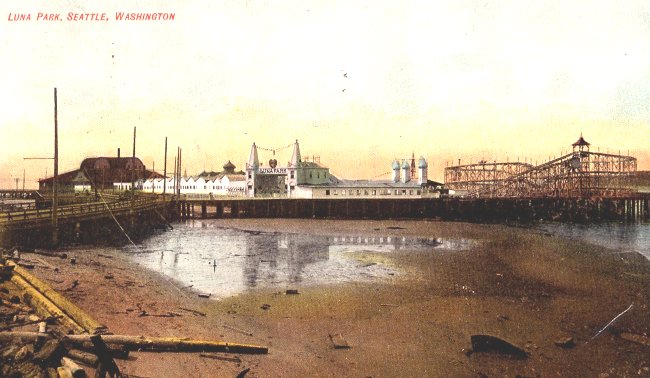 |
|||
|
Luna Park is shown here at low tide where it was built on the tide flats along Duwamish Head, not far from where Seattle’s first settlers landed in 1851 at Alki Point. The streetcar tracks are on the pier to the left and it would drop off passengers at the Luna Park Spire Entrance. Pilings were driven deep into the tide flats to allow the park to be built out over the water, like most Amusement Parks, which were very popular early in the 20th Century. |
|||
|
|
Early view of the Summer Garden Restaurant, famous for 10-cent Roast Beef Sandwiches. |
|
|
From the left you can see the Chutes, the Canals of Venice, the Giant Whirl and the Band Stand. |
||||||||||||||
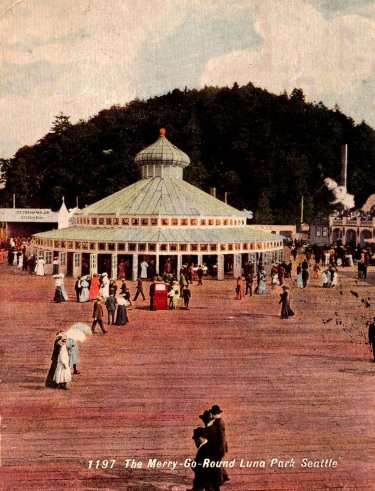 |
||||||||||||||
|
Luna boasted a Carousel with animals carved by the legendary Charles Looff. |
||||||||||||||
|
Construction of Luna Park began in 1906 under the direction of Charles I.D. Looff, who was famous for his intricate carvings of wooden horses and other animals used on Carousels he created at Coney Island, San Francisco and in Europe. |
||||||||||||||
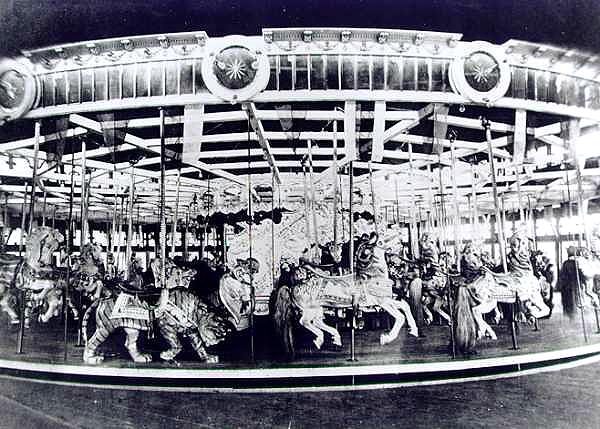 |
||||||||||||||
|
The four-row Looff Carousel formerly at Luna Park is now operating at Yerba Buena Gardens in San Francisco, California. |
||||||||||||||
|
The Looff Carousel was originally built for San Francisco, but because of the earthquake and fire, it was sent to Seattle instead. In 1914, the Looff Company moved it to San Francisco where it operated at Playland at the Beach. When Playland was demolished in 1972, the carousel was sold and moved to Roswell, New Mexico, where it sat in storage in for several years. The carousel was restored in the late 1970’s and leased to operators in Long Beach, California where it remained until several years ago. It was sold to the city of San Francisco where it operates today. |
||||||||||||||
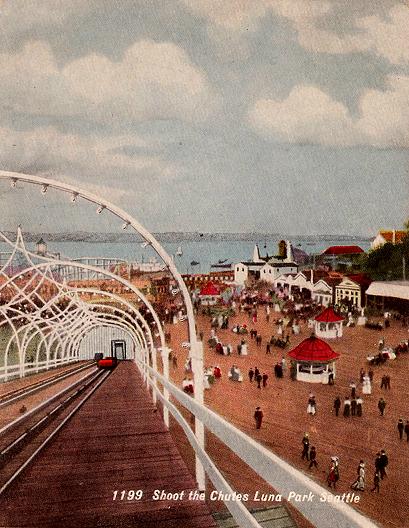 |
||||||||||||||
|
The Chutes afforded a spectacular view of Elliott Bay at high tide. The Figure 8 Coaster is visible on the left and the inside of the Park Entrance Spires are visible on the right. |
||||||||||||||
|
|
Rides and amusements spread out over the pier at Luna Park; there was the Figure 8 Roller Coaster, a Merry-Go-Round, the Shoot-the-Chutes, the Water Slide, a Giant Whirl, the Cave of Mystery and other rides common to Amusement Parks of the day. |
|
|
The Great Figure Eight Roller Coaster was one of Luna Park’s more popular rides. |
|
|
Another perspective of the Figure Eight Coaster. |
|
There was also a Canals of Venice, the Joy Wheel, an Infant Electrobator (birthing clinic with incubation chambers for newborn babies) and the Original Human Ostrich. |
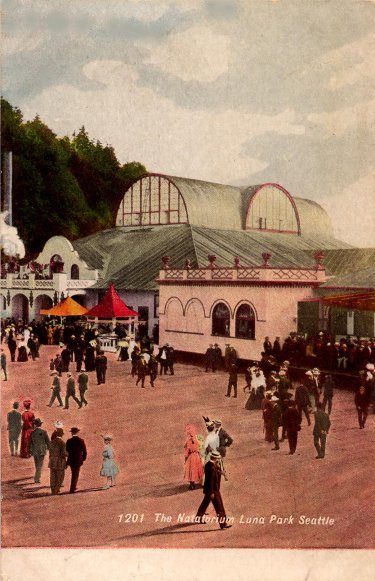 |
||||||
|
The Mainstay of Luna was the Natatorium. |
||||||
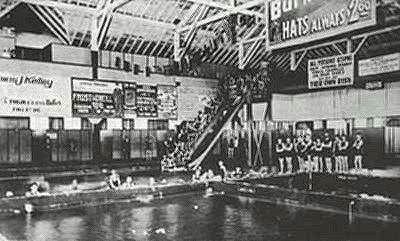 |
||||||
|
During hot summer days, swimmers would fill the Natatorium, which boasted both salt water and fresh water pools. |
||||||
|
|
Café and Natatorium shortly after opening in 1907. |
|
At night there was Christinsen’s Dancing Pavilion, which proved to be a popular place for the young affluent throngs that were attracted to the growing Metropolis of Seattle and its suburbs. |
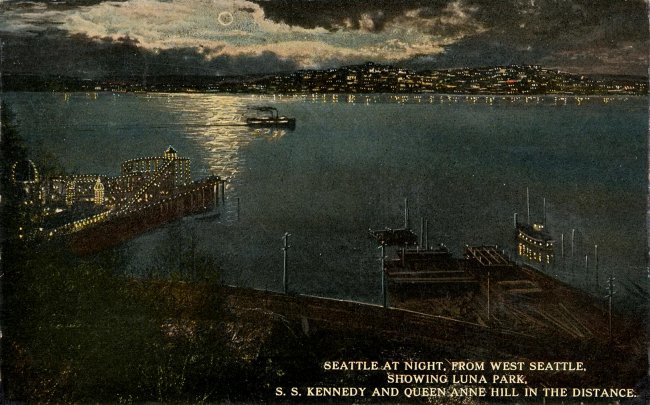 |
|
Shining as a glittering jewel, Luna Park lit up the night along the northern tip of West Seattle where it was visible from Downtown Seattle across Elliott Bay. A short Ferry ride was all it took to reach the magic kingdom known as the Coney Island of Seattle. |
|
|
The Giant Whirl gave one the feeling of being able to fly out over the pool for the Shoot the Chutes ride. |
|
Controversy frequently surrounds Amusement Parks and certainly Luna Park in Seattle had its share. Luna Park was home to the largest and best stocked-bar on Elliott Bay. |
|
|
This view shows the Giant Whirl, the Giant 8 Roller Coaster and the pool for the Shoot the Chutes ride. You can also see the three entrance towers to the Giant 8 Roller Coaster. To the right rear, is the back side of the Park Entrance. |
|
|
The same ornate bridge shown here is the same bridge that is shown in the previous picture. |
|
Shortly after the park opened, the more open-minded town of West Seattle was annexed into Seattle and Luna Park found itself at the center of controversy and the politics of morality. Scandal and politics eventually forced the early demise of Luna Park in 1913. All the rides were sold or torn down. All that remained was the Natatorium, which survived a couple more decades. An arsonist’s match finally erased all that remained of Luna when the Natatorium burned on April 14, 1931. About all that remains of Luna Park are a few faded memories. |
|
copyright © 2017 PdxHistory.com |
